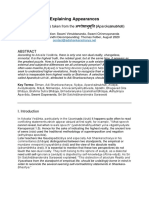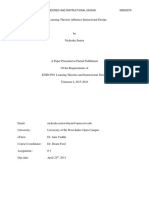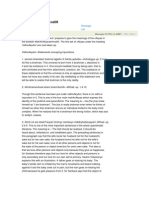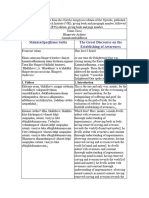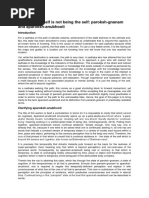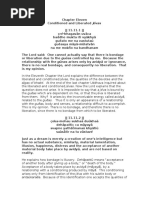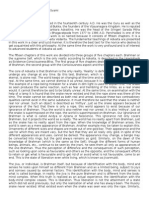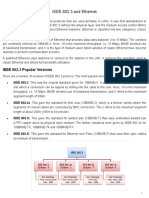Adhyāsa Can Occur Only if One Knows the Adhiṣṭhāna Exists, But Does Not Know What That Adhiṣṭhāna Is
Adhyāsa Can Occur Only if One Knows the Adhiṣṭhāna Exists, But Does Not Know What That Adhiṣṭhāna Is
Uploaded by
sun140371Copyright:
Available Formats
Adhyāsa Can Occur Only if One Knows the Adhiṣṭhāna Exists, But Does Not Know What That Adhiṣṭhāna Is
Adhyāsa Can Occur Only if One Knows the Adhiṣṭhāna Exists, But Does Not Know What That Adhiṣṭhāna Is
Uploaded by
sun140371Copyright
Available Formats
Share this document
Did you find this document useful?
Is this content inappropriate?
Copyright:
Available Formats
Adhyāsa Can Occur Only if One Knows the Adhiṣṭhāna Exists, But Does Not Know What That Adhiṣṭhāna Is
Adhyāsa Can Occur Only if One Knows the Adhiṣṭhāna Exists, But Does Not Know What That Adhiṣṭhāna Is
Uploaded by
sun140371Copyright:
Available Formats
Sāmānya-aṃśa-jñāna and viśeṣa-aṃśa-ajñāna of brahman
Question: Mokṣa is possible by mere knowledge only if bandha is an adhyāsa. Every
adhyāsa requires a locus or adhiṣṭhāna. For example, the adhyāsa of a snake
requires an adhiṣṭhāna such as a rope. In order for adhyāsa to occur on an
adhiṣṭhāna, there must simultaneously be sāmānya-aṃśa-jñāna and viśeṣa-aṃśa-ajñāna
of the adhiṣṭhāna. Sāmānya-aṃśa-jñāna is the general awareness of the adhiṣṭhāna,
in the form of 'this is'. Viśeṣa-aṃśa-ajñāna is the ignorance of the specific
identity of the adhiṣṭhāna. In other words, adhyāsa can occur only if one knows the
adhiṣṭhāna exists, but does not know what that adhiṣṭhāna is.
In the adhyāsa of a snake on the adhiṣṭhāna of rope, one simultaneously knows,
'Something is lying there on the road,' but does not know, 'It is a rope'. If
either one of these conditions is missing, adhyāsa will not occur. If one does not
perceive anything at all lying on the road, adhyāsa will not occur. Similarly, if
one both perceives something and knows it is a rope, then also adhyāsa will not
occur.
The entire universe is bandha. The only thing that is not bandha is brahman.
Therefore only brahman can be the adhiṣṭhāna for bandha-adhyāsa. But brahman is
niraṃśa, or without parts such as sāmānya and viśeṣa. Therefore, it is impossible
to have sāmānya-aṃśa-jñāna and viśeṣa-aṃśa-ajñāna with respect to brahman. Without
sāmānya-aṃśa-jñāna and viśeṣa-aṃśa-ajñāna of brahman, how is the adhyāsa of bandha
possible? And if bandha is not adhyāsa, then mokṣa is not possible by mere
knowledge. (For a detailed background of this question, click here.)
Answer: It is true that the adhiṣṭhāna of bandha can only be brahman. It is also
true that brahman is niraṃśa, and therefore sāmānya-aṃśa-jñāna and viśeṣa-aṃśa-
ajñāna of brahman are impossible. However, despite this logical impossibility, the
fact is every jīva1 is simultaneously both aware of and ignorant of brahman.
Every jīva is generally aware of brahman in the form of their own existence.
Brahman is always evident in the form of 'I am'. However, at the same time no jīva
knows that ever-evident brahman to be the limitless, absolute reality. Since the
existence of brahman is generally evident in the form of 'I am', this can be called
sāmānya-aṃśa-jñāna of brahman. Since the limitless, absolute reality of brahman is
unknown, this can be called viśeṣa-aṃśa-ajñāna.
Really speaking, the general awareness of brahman in the form of 'I am' is not
different from the limitless, absolute reality of brahman. However, a jīva
superimposes specific limitations on the limitless 'I am', such as 'I am the body',
'I am the mind', and so on. Thus 'I am the limitless, absolute reality' appears to
be the specific identity of brahman that the jīva does not know. In reality, when
the limitations of body and mind are negated, the remaining 'I am' is itself
limitless and absolute. No further specific knowledge is necessary. In other words,
the so-called sāmānya-aṃśa-jñāna of brahman, 'I am', is itself the so-called
viśeṣa-aṃśa-jñāna that 'I am the limitless, absolute reality'. The 'sāmānya-aṃśa'
and 'viśeṣa-aṃśa' of brahman are one and the same, because brahman is really
niraṃśa.
Thus, even though brahman is niraṃśa, it appears to have sāmānya-aṃśa and viśeṣa-
aṃśa to the ignorant jīva. The jīva is aware of the apparent sāmānya-aṃśa of
brahman, but does not know that that very 'sāmānya-aṃśa' is really limitless and
absolute. Due to this simultaneous awareness and ignorance of brahman, the adhyāsa
of bandha on brahman is possible. Since bandha is adhyāsa, it can be destroyed by
mere knowledge.
Based on topic 98
1. Here, the word 'jīva' refers only to an individual without brahma-jñāna.
You might also like
- Spamming Checks SauceDocument14 pagesSpamming Checks Saucekenishaskinnerz90% (20)
- CVT Comet 780Document1 pageCVT Comet 780Wagner Oliveira100% (1)
- D61ex-12 Shop PDFDocument716 pagesD61ex-12 Shop PDFDiego Orlando Santos Buitrago100% (4)
- Census Income ProjectDocument4 pagesCensus Income ProjectAmit PhulwaniNo ratings yet
- ब्रह्मज्ञानावलीमाला (Brahmajñānāvalīmālā)Document4 pagesब्रह्मज्ञानावलीमाला (Brahmajñānāvalīmālā)Hapayko0% (1)
- The Basics of The Three Philosophies by Maharanyam Muralidhara SwamigaLDocument10 pagesThe Basics of The Three Philosophies by Maharanyam Muralidhara SwamigaLNarayanan MuthuswamyNo ratings yet
- Thirty Verses of VasubandhuDocument11 pagesThirty Verses of Vasubandhurishi patel100% (2)
- Summary of VivekachudamaniDocument3 pagesSummary of VivekachudamaniBr SarthakNo ratings yet
- Explaining Appearances: Vedāntic Maxims taken from the अपरोक्षानुभूति (Aparokṣānubhūti)Document9 pagesExplaining Appearances: Vedāntic Maxims taken from the अपरोक्षानुभूति (Aparokṣānubhūti)ravikiranjanaNo ratings yet
- Seniorn Edid6501 Assignment 3Document18 pagesSeniorn Edid6501 Assignment 3api-278608301No ratings yet
- Maha Parivrajaka: Brahmasótra-CatuèsótrêDocument142 pagesMaha Parivrajaka: Brahmasótra-CatuèsótrêRafaelNo ratings yet
- The Seeming Impossibility of Bandha-AdhyāsaDocument2 pagesThe Seeming Impossibility of Bandha-Adhyāsasun140371No ratings yet
- 12 AvidyaDocument26 pages12 Avidyaयामिनी भारंबेNo ratings yet
- Siddhantalesa1 5Document4 pagesSiddhantalesa1 5SrinivasaRao RupanaguntaNo ratings yet
- Kathopanishad 2-1-11Document3 pagesKathopanishad 2-1-11SLNarasimhanNo ratings yet
- Vedanta Darśanam Fifth 10 LessonsDocument15 pagesVedanta Darśanam Fifth 10 LessonsgmurthyNo ratings yet
- Sutta Anatta-Lakkhana (SN 22.59) - Eng, Pali & Indo - Aug 2016Document5 pagesSutta Anatta-Lakkhana (SN 22.59) - Eng, Pali & Indo - Aug 2016Garvin GoeiNo ratings yet
- Scriptural VsDocument10 pagesScriptural VsBoris Bhāskara MarjanovicNo ratings yet
- Mah Av Akyaratn Avali HDocument77 pagesMah Av Akyaratn Avali HVetri Manian0% (1)
- The Nectar of ImmortalityDocument4 pagesThe Nectar of ImmortalityLucas AlexandreNo ratings yet
- 9 Brahman Separate From The JagatDocument7 pages9 Brahman Separate From The Jagatयामिनी भारंबेNo ratings yet
- Definition Of Mêyê: Öeqe) Eëee Úeøne-Jºeúe¡-Óeµees-¼E©²Eefóµekàe Μeeëee Dfúóe>Document8 pagesDefinition Of Mêyê: Öeqe) Eëee Úeøne-Jºeúe¡-Óeµees-¼E©²Eefóµekàe Μeeëee Dfúóe>tamilvananrNo ratings yet
- ந கர்மணா ந ப்ரஜயா தDocument8 pagesந கர்மணா ந ப்ரஜயா தN A NarayananNo ratings yet
- Chapter 7.Document2 pagesChapter 7.Manoj KumarNo ratings yet
- 4 JivaprakarnamDocument145 pages4 JivaprakarnamAnil KanthiNo ratings yet
- Consciousness in Advaita Vedanta - Hindupedia, The Hindu EncyclopediaDocument5 pagesConsciousness in Advaita Vedanta - Hindupedia, The Hindu Encyclopediatejasdangodra99No ratings yet
- Advaita ManjariDocument28 pagesAdvaita ManjariRamani RamaseshanNo ratings yet
- PRABODHASUDHĀKARA7Document4 pagesPRABODHASUDHĀKARA7vipinsunariaNo ratings yet
- Chidabhasa - Advaita VisionDocument8 pagesChidabhasa - Advaita Visionwap vcdNo ratings yet
- Chapter 2 - Commentaries On Important VersesDocument20 pagesChapter 2 - Commentaries On Important Versesom godboleNo ratings yet
- Anupalabdhi PramānaDocument36 pagesAnupalabdhi PramānaMinakshi KanuNo ratings yet
- The Concept of Ātman in Nyāya PhilosophyDocument12 pagesThe Concept of Ātman in Nyāya Philosophyratjaga taraNo ratings yet
- Swami PanchadasiDocument7 pagesSwami PanchadasiGita RamNo ratings yet
- 123 EV-Lesson11.unlockedDocument15 pages123 EV-Lesson11.unlockedgkvish@gmail.comNo ratings yet
- CTR Assignment1Document19 pagesCTR Assignment1alphabetagammadeltayetaNo ratings yet
- KenakathaDocument12 pagesKenakathac1a5c7No ratings yet
- Advaita Vedanta Philosophy A Short IntroDocument11 pagesAdvaita Vedanta Philosophy A Short Introguille roamNo ratings yet
- Sankara Answer - FinalDocument2 pagesSankara Answer - Finalsaugat suriNo ratings yet
- Brihadaranyaka UpDocument702 pagesBrihadaranyaka UpChandrasekaran Srinivasan100% (1)
- Maha Satipaththana SutraDocument48 pagesMaha Satipaththana Sutrapaul GaoNo ratings yet
- By Swami Paramananda BharatiDocument63 pagesBy Swami Paramananda BharatiRafaelNo ratings yet
- Knowing The Self Is Not Being The Self: Paroksh-Gnanam and Aparoksh-AnubhootiDocument6 pagesKnowing The Self Is Not Being The Self: Paroksh-Gnanam and Aparoksh-AnubhootiRenuka DeviNo ratings yet
- Asti, Bhati, Priyam, Nama, Rupam - Peter BonniciDocument4 pagesAsti, Bhati, Priyam, Nama, Rupam - Peter BonniciValentin ConstantinNo ratings yet
- Om Asato Ma SadgamayaDocument22 pagesOm Asato Ma SadgamayaSivasonNo ratings yet
- The Higher PowerDocument40 pagesThe Higher PowerTenneti Sri RamNo ratings yet
- Advaita MakarandaDocument7 pagesAdvaita MakarandaRadhika MehtaNo ratings yet
- Laghu Vakya Vritti Class NotesDocument136 pagesLaghu Vakya Vritti Class NotesRajarshi DuttaNo ratings yet
- Lect 12Document27 pagesLect 12sksgdramahubNo ratings yet
- Brahmanandavalli MeaningDocument20 pagesBrahmanandavalli MeaningvijayNo ratings yet
- Mitras Indian Philosophy 241108 234003Document46 pagesMitras Indian Philosophy 241108 234003Kamakshi GargNo ratings yet
- CKTG Cumulative GlossaryDocument24 pagesCKTG Cumulative GlossarySure GurungNo ratings yet
- Aìgas of Bhakti. at The End of The Last Chapter Uddhava Inquired AboutDocument28 pagesAìgas of Bhakti. at The End of The Last Chapter Uddhava Inquired AboutDāmodar DasNo ratings yet
- Siddhantalesa1 1Document4 pagesSiddhantalesa1 1Govinda ReddyNo ratings yet
- Pratasmarana StotramDocument5 pagesPratasmarana StotramPoorviStrNo ratings yet
- SivananabodhamDocument52 pagesSivananabodhamSivasonNo ratings yet
- Panchadasi of Sri Vidyaranya SvamiDocument7 pagesPanchadasi of Sri Vidyaranya SvamiAshish Karandikar0% (1)
- Lessons in Advaita - II - Advaita PracticeDocument13 pagesLessons in Advaita - II - Advaita PracticeDr Srinivasan Nenmeli -KNo ratings yet
- Meaning Of: VedantaDocument14 pagesMeaning Of: Vedantaarniko studioNo ratings yet
- Jïäna and Bhakti: Sädhana of The Jïäné, and The Definitions of Words Like Yama AreDocument19 pagesJïäna and Bhakti: Sädhana of The Jïäné, and The Definitions of Words Like Yama AreDāmodar DasNo ratings yet
- Summary DDVDocument5 pagesSummary DDVPalaniappan ChidambaramNo ratings yet
- Kena Upanishad11 PDFDocument41 pagesKena Upanishad11 PDFVipul OzaNo ratings yet
- 2_SAMBHASA-12Document11 pages2_SAMBHASA-12aniktiwari1212No ratings yet
- The Nature of Happiness According to Advaita VedantaFrom EverandThe Nature of Happiness According to Advaita VedantaNo ratings yet
- ASS 034 Bhagavad Gita Sankara Bhashya With Anandagiri Tika - Kasinath Sastri Agase 1896Document621 pagesASS 034 Bhagavad Gita Sankara Bhashya With Anandagiri Tika - Kasinath Sastri Agase 1896sun140371No ratings yet
- Bhagavat Darshan Sw Akhandananda Saraswati P 1Document673 pagesBhagavat Darshan Sw Akhandananda Saraswati P 1sun140371No ratings yet
- MandukyaUpanishadKarikaWithBhashya SwamiNikhilananda TextDocument390 pagesMandukyaUpanishadKarikaWithBhashya SwamiNikhilananda Textsun140371No ratings yet
- Adhyāsa Does Not Require SimilarityDocument1 pageAdhyāsa Does Not Require Similaritysun140371No ratings yet
- Hindi Book-Sri Vichar Sagar of Sadhu Nischaldas With Hindi Tika by Pitambara1917Document459 pagesHindi Book-Sri Vichar Sagar of Sadhu Nischaldas With Hindi Tika by Pitambara1917sun140371No ratings yet
- Amarnath Yatra - List of Doctors - West Bengal-Yatra-2013 PDFDocument2 pagesAmarnath Yatra - List of Doctors - West Bengal-Yatra-2013 PDFsun140371No ratings yet
- Reference List With Links To Pubmed: Wm-2000™: View AbstractDocument3 pagesReference List With Links To Pubmed: Wm-2000™: View Abstractsun140371No ratings yet
- Heritage of Open Air Square Temple Discovered in Russia: Avinash PatraDocument17 pagesHeritage of Open Air Square Temple Discovered in Russia: Avinash Patrasun140371No ratings yet
- The Vedanta Kesari August 2012Document56 pagesThe Vedanta Kesari August 2012sun140371No ratings yet
- Certificate in International Business English Training (Cert IBET)Document2 pagesCertificate in International Business English Training (Cert IBET)Ika AstoNo ratings yet
- Mathematical Statistics (MA212M) : Lecture SlidesDocument15 pagesMathematical Statistics (MA212M) : Lecture SlidesAkshay NarasimhaNo ratings yet
- Relation and Function 2020Document23 pagesRelation and Function 2020Jaena Perez Ariola100% (1)
- Adrian Mejia BlogDocument10 pagesAdrian Mejia Bloglonesome.rarNo ratings yet
- PREPOSITIONSDocument2 pagesPREPOSITIONSrobloxmailidNo ratings yet
- IEEE 802.3 and EthernetDocument3 pagesIEEE 802.3 and EthernetDon WaltonNo ratings yet
- Data Mining - Utrecht University - 10. SlidesDocument49 pagesData Mining - Utrecht University - 10. SlidesLeonardo VidaNo ratings yet
- Wellness Massage Module 1-EDITEDDocument17 pagesWellness Massage Module 1-EDITEDEverly OballoNo ratings yet
- Lecture 12-Flow MetersDocument33 pagesLecture 12-Flow MetersRaheel ShahNo ratings yet
- Eni Lubricants Brochure MarineDocument12 pagesEni Lubricants Brochure MarineSintéticaNo ratings yet
- Atkinson, Meera - The Poetics of Transgenerational Trauma (2019, Bloomsbury Academic)Document241 pagesAtkinson, Meera - The Poetics of Transgenerational Trauma (2019, Bloomsbury Academic)Themozhi Jawahar100% (2)
- Synopsis Format - 2022-23Document22 pagesSynopsis Format - 2022-23Aditya Sangita Kisan SonawaneNo ratings yet
- Calculations Membrane ProcessesDocument3 pagesCalculations Membrane ProcessesAnonymous 20VAruNo ratings yet
- Rcug-Ahyz1 TC1Document38 pagesRcug-Ahyz1 TC1Site Engineeringtia100% (1)
- Xspec TutorialDocument25 pagesXspec TutorialPRASAD RAVICHANDRANNo ratings yet
- The Photographer's EyeDocument16 pagesThe Photographer's EyeNelson Gonzalez Escalante0% (1)
- 4628HDocument154 pages4628HBrahim BaluchNo ratings yet
- Survival Rate of Different Fixed Posterior Space Maintainers Used in Paediatric Dentistry - A Systematic ReviewDocument8 pagesSurvival Rate of Different Fixed Posterior Space Maintainers Used in Paediatric Dentistry - A Systematic ReviewAndrea MartinezNo ratings yet
- Guidelines Considerations For Open Pit DesignDocument17 pagesGuidelines Considerations For Open Pit DesignMohammed AliNo ratings yet
- DrdoDocument2 pagesDrdoAvneet SinghNo ratings yet
- The Wood-Mizer Way: Issue 89Document32 pagesThe Wood-Mizer Way: Issue 89jmooney3381100% (3)
- Optical Communications Questions and Answers - Cable Design: Prev NextDocument7 pagesOptical Communications Questions and Answers - Cable Design: Prev NextKumar MukeshNo ratings yet
- ISZ (Increment and Skip If Zero) Instruction: Computer ArchitectureDocument12 pagesISZ (Increment and Skip If Zero) Instruction: Computer ArchitectureSankalp GuptaNo ratings yet
- Fulltext PDFDocument17 pagesFulltext PDFEl Youbi MohammedNo ratings yet
- Learning and The BrainDocument5 pagesLearning and The BrainBrendan MakidonNo ratings yet








